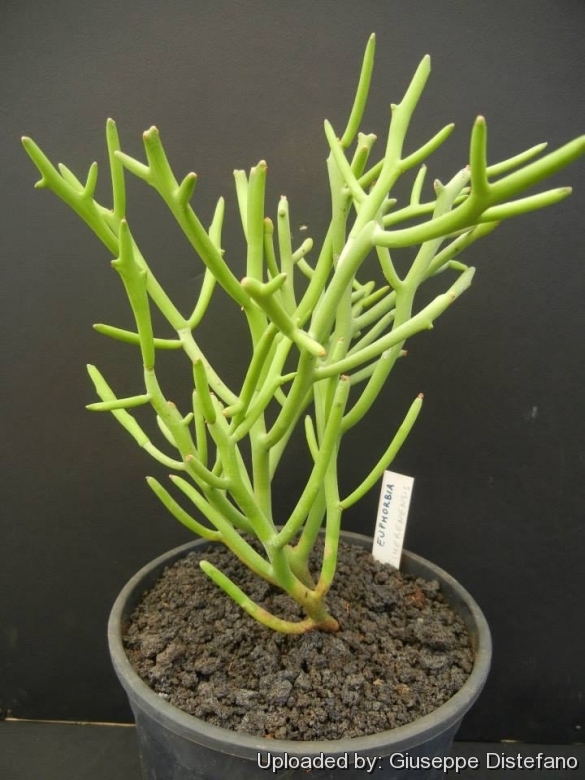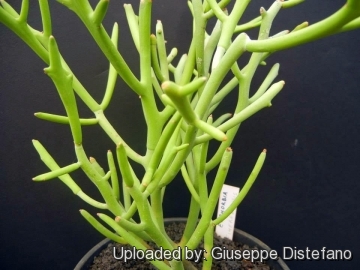
Euphorbia fiherenensis Photo by: Giuseppe Distefano
Origin and Habitat: Euphorbia fiherenensis is endemic to South-west Madagascar: Tulear to Fort-Dauphin (delta of the Fiherenana river, slopes of La Table and on the way to St. Augustin) It is common throughout its range where it often forms wide pure stands. (Extent of occurrence 39,064.8 km and area of occupancy 10,950.2 km). Recorded from 17 localities and comprises four to nine subpopulations.
Altitude: 0-500 metres above sea level.
Habitat and Ecology: It grows in limestone slopes in subarid thicket together with Euphorbia arahaka. There are some threats like habitat degradation, fire and habitat clearing for charcoal, but these do not yet trigger a threatened status. E. fiherenensis is also used locally to feed cattle.
Synonyms:
Description: Euphorbia fiherenensisSN|26568]]SN|26568]] is a shrubby succulent trees to 6(-10) m tall exhibiting a corraliform branch structure, which is a xerophitic adaptation to the arid climate.
Branches: About 6 mm in diameter, Succulent, virgate, jointed with segments to 6 cm long, leafless.
Leaves: 5 x 3 mm, deciduous.
Inflorescences (cymes): In dense clusters.
Flowers (Cyathia): Unisexual; nectar-glands 3, elliptic, separate.
Fruits: Globose, approx. 9 mm across, Peduncle to 7 mm long, recurved.
Seeds: Globose, with a caruncle.
Bibliography: Major references and further lectures
1) James Cullen, Sabina G. Knees, H. Suzanne Cubey “The European Garden Flora Flowering Plants: A Manual for the Identification of Plants Cultivated in Europe, Both Out-of-Doors and Under Glass” Cambridge University Press, 11/ago/2011
2) Urs Eggli “Illustrated Handbook of Succulent Plants: Dicotyledons” Springer, 2002
3) Cremers, G. “Les euphorbes coralliformes de Madagascar.” Bull. Jard. Bot. Belg 54: 23–64. 1984
4) Leandri, J. “Les arbres et grands arbustes malgaches de la famille des Euphorbiacees.” Naturaliste Malgache 4(1): 47–82. 1952
5) Leandri, J. “Euphorbiaceae.” Cat. Pl. Madag., Euphorb. 2(23): 1–51. 1935
6) Schill, R. “Cytotaxonomische untersuchungen an sukkulenten vertretern der gattung Euphorbia L. aus Madagaskar.” Ber. Deutsch. Bot. Ges. 84(1/2): 71–78. 1971
7) Rauh, W. “Succulent and Xerophytic plants of Madagascar.” Vol I. Strawberry Press, Mill Valley.1995.
8) Rauh, W. 1998. “Succulent and Xerophytic plants of Madagascar.” Vol II. Strawberry Press, Mill Valley 1998
9) Haevermans, T. 2004. Euphorbia fiherenensis. In: IUCN 2013. “IUCN Red List of Threatened Species.” Version 2013.2. <www.iucnredlist.org>. Downloaded on 10 April 2014.
 Euphorbia fiherenensis Photo by: Giuseppe Distefano
Euphorbia fiherenensis Photo by: Giuseppe DistefanoSend a photo of this plant.The gallery now contains thousands of pictures, however it is possible to do even more. We are, of course, seeking photos of species not yet shown in the gallery but not only that, we are also looking for better pictures than those already present.
Read More... Cultivation and Propagation: It is an easy species to grow that is suited for a hot dry spot in the garden. But young plant are happy growing indoors in a decorative pot. Give the plant an airy growing medium which mainly consists of non organic material such us clay, pumice, lava grit, and only a little peat or leaf-mould. Water regularly during the active growing season from March to September. No water should ever be allowed to stand around the roots. Keep almost completely dry in winter. If plant becomes reddish, this is a sign that the roots have not developed properly. It is a relatively fast growing and long lived plant and once established, it will be content in its position and with its soil for years. It can tolerate moderate shade, and a plant that has been growing in shade should be slowly hardened off before placing it in full sun as the plant will be severely scorched if moved too suddenly from shade into sun. Like quite small pots, repott in very later winter, early spring. Can be pruned for shape and branching.
Frost tollerance: Frost tender, it can withstand temperatures only above 2º C.
Pests and diseases: It is prone to mealy bugs and rarely scale.
Propagation: It is easy to propagate by cuttings in late spring to summer, just take a cutting of the plant dip it in rooting hormone, allow it dry for for a week prior to planting in the ground (preferably dry, loose, extremely well draining soil).
Warning: All parts of Euphorbias ooze a milky sap when damaged or cut. Contact with this sap may cause dermatitis in some people, and in the eyes the sap can cause temporary blindness which may last for several days.












